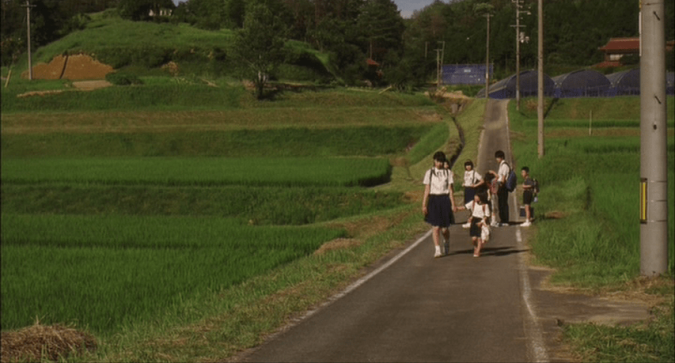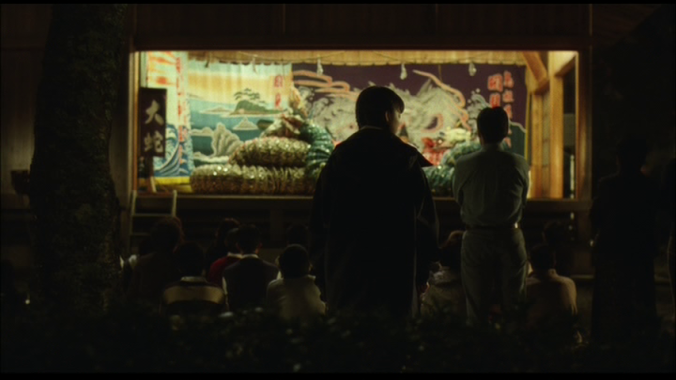 Soyo is the oldest girl in her tiny village whom we follow in A Gentle Breeze in the Village for about two years until she enters high school. A new boy arrives from far-away Tokyo, and everyone assumes a romance will develop, but it is very tentative and awkward, as we would hope to see from students in middle school. There is no plot as such, just a portrait of Soyo’s life, told in several scenes that follow the seasons, usually indicated by transition shots of flowers, with occasional bits of narration by Soyo herself. It is, as the title suggests, a very gentle movie, a portrait of a girl gradually beginning to come to terms with herself, as well as a loving portrait of rural Japanese life. We see a walk over the nearby hills to the beach in summer, a trip to the festival in the larger town nearby, and even the class trip to Tokyo, but mostly we see Soyo in the village and in school, which she dearly loves. Told with simplicity and honest sincerity, it is one of the loveliest of Japan’s presentations of the early teen-aged years.
Soyo is the oldest girl in her tiny village whom we follow in A Gentle Breeze in the Village for about two years until she enters high school. A new boy arrives from far-away Tokyo, and everyone assumes a romance will develop, but it is very tentative and awkward, as we would hope to see from students in middle school. There is no plot as such, just a portrait of Soyo’s life, told in several scenes that follow the seasons, usually indicated by transition shots of flowers, with occasional bits of narration by Soyo herself. It is, as the title suggests, a very gentle movie, a portrait of a girl gradually beginning to come to terms with herself, as well as a loving portrait of rural Japanese life. We see a walk over the nearby hills to the beach in summer, a trip to the festival in the larger town nearby, and even the class trip to Tokyo, but mostly we see Soyo in the village and in school, which she dearly loves. Told with simplicity and honest sincerity, it is one of the loveliest of Japan’s presentations of the early teen-aged years.
The most amazing part of the story to American eyes is the school itself. There are four teachers for only six students – Soyo, an 8th grader, two girls in 7th grade, and two girls in elementary school along with Soyo’s little brother Kotaro, who will graduate from elementary to middle school classes (and uniform) half way through the film. Hiromi, the new boy, is also an 8th grader, Though there are multiple teachers, the kids stay in one classroom for middle school, one for elementary, moving their desks to the dining room for lunch and back again for classes. Lunch is delivered from a central kitchen, so it is often cold, but otherwise the school operates as if there were hundreds of students.
The students take turns serving the food, there is even a PA speaker on which they take turns making announcements about the lunch menu, they clean the hallways with even Sachiko the 1st grader pushing her cloth along the hall, the kids all rise and bow for the teacher’s entrance. Though she has a happy family life, with Mother and Dad and Kotaro living on the farm with Grandmother and Grandfather, the school is her real world, with the other girls all little sisters in her mind.
Hiromi adjusts reasonably well, without the open resentment or insolence we would expect for a Tokyo boy suddenly sent to the back of beyond. He misses his old life and still makes phone calls to his old school chums in Tokyo but participates in all the school activities without resistance. As the only boys in the school or at the beach, he and Kotaro immediately bond through rough-housing games, though he is generally cold and abrupt with Soyo and the other girls.
The village is genuinely tiny, with one general store, a barbershop, and a post office that also acts as the bank. A long walk will take the kids to a train stop to go to the nearest town, large enough for two high schools, a big annual festival, and a real department store. There are no younger babies around to follow Sachiko, the 1st grader, into the village school. Thus, it is in a sense a movie about the passing of the traditional way of life, but there is no attempt to make this an issue. (Similarly, there is no sign of any older teens; there is the strong assumption that when Soyo and Hiromi go to high school, they will board at the school which is too far for a daily commute by train, though this is never explicitly stated.) As in so many Japanese movies, life is what it is, and our focus is on Soyo, who loves the world she is in. She is calmed during her class trip to Tokyo by cupping her ears to hear the same sound coming off the buildings as came from the mountains at home.
All is not sweetness and light. Hiromi’s mother has returned to her parents after a divorce and initially Soyo’s father demands that she have nothing to do with him. We assume this is because she is divorced, but we eventually learn that he had assumed they would be married before she ran away from the village to marry the man who ultimately left her. Soyo begins to worry if the two are having an affair after she sees them together behind the barber shop. The other girls have sensed that the postman is in love with Soyo and keep trying to find excuses to leave her alone with him during the festival they visit, but she has no inkling of his feelings. Hiromi actually refers to her as Raccoon Face when talking to his friends in Tokyo, and when she finally agrees to a kiss as his graduation present, he doesn’t respond because there is no love in it, not realizing that she has in fact fallen in love with him. When they go to the beach, they shun a short cut because a woman had jumped from a bridge along the route and they think she still haunts the path.
but she has no inkling of his feelings. Hiromi actually refers to her as Raccoon Face when talking to his friends in Tokyo, and when she finally agrees to a kiss as his graduation present, he doesn’t respond because there is no love in it, not realizing that she has in fact fallen in love with him. When they go to the beach, they shun a short cut because a woman had jumped from a bridge along the route and they think she still haunts the path.
We have seen the class trip in many other movies about school, and I had just assumed it was like field trips in American schools. Apparently, however, it is a ritual for 9th graders throughout the country (which helps explain the age of the kids in Battle Royale and explains as well the outing for the adult students in A Class to Remember who are following the middle school curriculum). In this case, the destination is chosen by Soyo, not the teachers. She picks Tokyo because she thinks that Hiromi will be glad to see his old friends, but it is clear than none of the three teachers along have ever been there as well and are almost as exhausted and confused by the city as she is.
Based on a manga first published in 1996, the movie may have a bit of autobiographical nostalgia about it – Soyo herself draws a manga and when she goes shopping for gifts to take back home from Tokyo, all the school girls are wearing Ko-gal socks, which she buys for the other middle school girls, a fad that reportedly died out around 2000 or so. But Soyo’s father has a cell phone, which he actually answers at the dinner table, so the village is not cut off from modernity in any significant way.
Soya is played with relaxed naturalism by the popular teen model Kaho, and in a long tradition of Japanese movie-making, all the other kids are completely genuine and believable. Nobuhiro Yamashita’s direction is as gentle as a breeze, often settling into long takes with quiet camera movement. Soya’s farewell to her classroom is an exceptional sequence, but the entire movie operates on a similar high standard.
It is a gentle and lovely and memorable movie, a shining example of a particular kind of movie that only the Japanese seem to make with any regularity.




Pingback: Adrift in Tokyo (2007) | Japanonfilm
Pingback: Million Yen Girl / Hyakuman-en to nigamushi onna (2008) | Japanonfilm